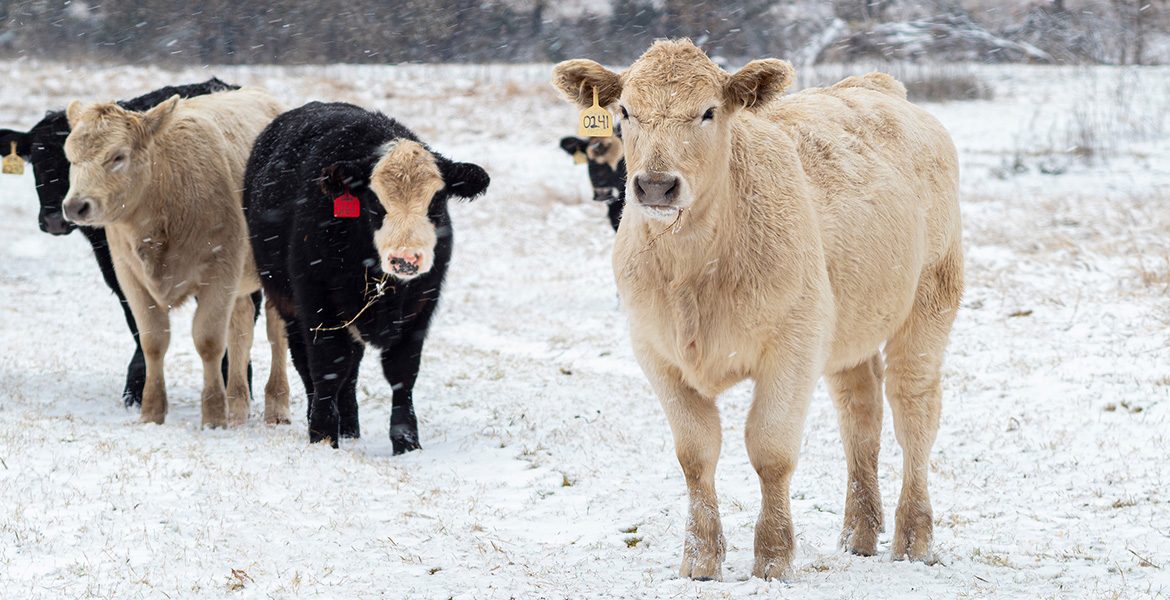
Source: OSU Department of Agricultural Sciences and Natural Resources | Feb. 18, 2021
At this time, consumers are not likely to experience any sudden spike in beef prices brought on by mid-February snowstorms. The beef industry itself will be weathering the consequences, said Oklahoma State University experts.
“Cold weather robs production, but the overall effect shows up more as increased costs to cattle operations, feedlots and processors than prices at the grocery store,” said Derrell Peel, OSU Extension livestock marketing specialist and holder of the university’s Charles Breedlove Professorship in Agribusiness.
Losing power is the primary issue for feedlots and packing plants. For example, feedlots need to keep their animals fed but they cannot run their feed mills without electricity or natural gas to power the boilers and process the cattle feed. Disruption to feeding programs doubtless will affect carcass weights of livestock in the feedlots, but it will take a few weeks before the extent is known and is reported as part of U.S. Department of Agriculture data.
Cattle producers may notice disruptions as they try to buy extra feed to meet increased energy requirements of their livestock. However, the primary costs are from a management and labor perspective. Many producers have been working day and night to ensure the well-being of their animals by hauling hay to bale feeders and pastures, providing windbreaks and breaking ice on frozen farm ponds so animals can drink.
“Fortunately, the mid-February storms resulted in snowfall that was relatively dry,” Peel said. “That has helped mitigate problems and associated operational and health costs that would be present if the livestock had wet hair coats.”
All things being equal, the thick, winter hair coat of cattle provides good insulation from many of the negative effects of wintertime weather. Animals with sufficient access to unfrozen water and a ready supply of nutritional feed manage just fine, especially when they can shelter behind windbreaks. Get the hair coat wet and its insulative properties are diminished, sometimes greatly depending on just how wet and the condition of the individual animal.
“The lower critical temperature on cattle in good body condition and having a dry, winter hair coat is about 32 degrees,” said Paul Beck, OSU Extension beef cattle specialist and holder of the university’s Dennis and Marta White Endowed Chair in Animal Science. “Get the hair coat wet and the lower critical temperature is 40 degrees or above.”
Research shows the energy needs of cattle increase by about 1% for every degree below lower critical temperature. That means more feed is needed by the livestock, with producers footing the bill.
Early calves born during these storm systems may have death losses approaching 15-20% or more, Beck said.
“Although heartbreaking and a very real economic loss for affected producers, this will likely result in only a slight increase in reported mortality overall compared to what would typically be expected for spring-calving herds,” he said.
An issue producers, processors and feedlot operators share with consumers not active in the beef industry is the prospect of burst water pipes. Repairs must be made, and they can be costly if the damage is severe, not to mention it may take weeks to fully resolve the problem. If a producer relies on wells or rural water sources, then burst water pipes could comparatively be an even greater hardship. A burst pipe can compromise the entire well-pumping system, as an example.
OSU Division of Agricultural Sciences and Natural Resources fact sheets detailing research-based information about cattle management and livestock economics are available online and through all OSU Extension county offices.
